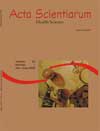<b>Study of the incidence of clinical samples belonging to the genus <em>Candida<em> obtained from different anatomic sites</b> - DOI: 10.4025/actascihealthsci.v29i1.104
Abstract
Candidiasis is the main human fungal infection caused by yeasts of the genus Candida which are part of endogenous microflora of the human body. The aim of this study was to analyze the incidence of Candida species obtained from different infection processes. A total of 90 clinical samples were isolated in Sabouraud agar supplemented with antibiotics, and identified by CHROMagar Candida ®. Among them, 58 samples were isolated from vaginal secretion, 17 samples were from nail, 8 were from sputum and 7 were from skin. From the former, 89% were identified as C. albicans, followed by non albicans species, being 5.1% C. krusei, 1.7% C. glabrata, 1.7% C. tropicalis and 1.7% Candida sp. For samples isolated from nail it was not observed prevalence of C. albicans (28%); species nonalbicans corresponded to 70% of the samples, being 14% C. glabrata, 528% C. krusei and 28% Candida sp. The prevalence of non albicans species was also observed from samples isolated from nail, being 29% C. glabrata, 23% C. krusei, 23% Candida sp and 11% C. tropicalis. C. albicans in this infection site represented only 11%. Only two species were present in samples from sputum, being 75% C. albicans and 25% C. tropicalis. Samples identified as C. albicans in CHROMagar Candida ® agar were confirmed by growth at 42ºC and by seminested PCR approach.Downloads
Download data is not yet available.
Published
2007-12-18
How to Cite
Furlaneto-Maia, L., Spcian, A. F. L., Trörn, D. S. W., Oliveira, M. T. de, & Furlaneto, M. C. (2007). <b>Study of the incidence of clinical samples belonging to the genus <em>Candida<em> obtained from different anatomic sites</b> - DOI: 10.4025/actascihealthsci.v29i1.104. Acta Scientiarum. Health Sciences, 29(1), 33-37. https://doi.org/10.4025/actascihealthsci.v29i1.104
Issue
Section
Clinical Analysis
DECLARATION OF ORIGINALITY AND COPYRIGHTS
I Declare that current article is original and has not been submitted for publication, in part or in whole, to any other national or international journal.
The copyrights belong exclusively to the authors. Published content is licensed under Creative Commons Attribution 4.0 (CC BY 4.0) guidelines, which allows sharing (copy and distribution of the material in any medium or format) and adaptation (remix, transform, and build upon the material) for any purpose, even commercially, under the terms of attribution.
Read this link for further information on how to use CC BY 4.0 properly.























5.png)







